Growing carrots from seed can be a bit tricky, but it’s totally worth it! In this post, I will show you how to plant carrot seeds the right way, with detailed step by step instructions, and seedling care tips too.
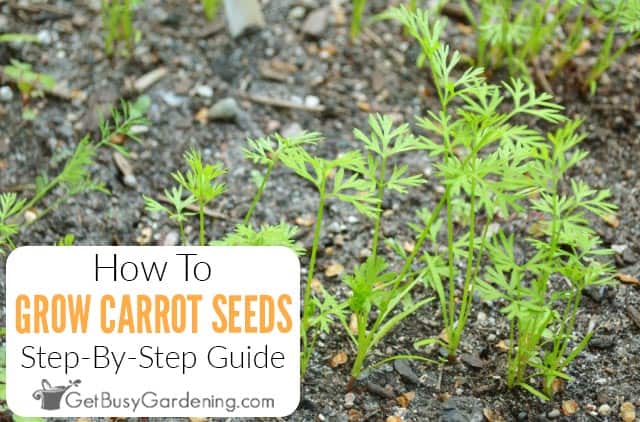
If you’ve never planted carrot seeds before, you might be expecting a complex process. But nothing could be further from the truth.
They get a bad wrap because they can be finicky. But growing carrots seeds is actually very easy once you know how.
So, if you’re ready to finally be successful, then this is for you! Below I will walk you through all that you need to know to grow carrots from seed, step by step.
Growing Carrots From Seed
Once you know how to plant carrot seeds, and how long it will take, you’ll find that you can easily grow any type that you want. And trust me, there are plenty of varieties to choose from!
Types Of Carrot Seeds To Plant
Believe it or not, there are tons of different types of carrot seeds you can plant in your garden. The exact one you choose will depend on your preferred flavor or color.
You could try a couple of different varieties, or get a mixed pack to see which you like the best. Here are a few of my favorites…
- Kaleidoscope (rainbow mix)
- Danvers
- Scarlet Nantes
- Sugarsnax
- Short Stuff
Don’t worry, the steps for growing carrots from seed are the same no matter which type you choose. Heck, you could even mix and match them.
Recommended Starting Methods
For the best success, it is super important to use the right method for planting carrot seeds – and that is direct sowing.
I don’t recommend starting them indoors or winter sowing them. That’s because transplanting carrot seedlings almost always causes the roots to become deformed.
So don’t waste your time experimenting. Stick to planting them directly in your garden for the best success.
Related Post: 3 Seed Starting Methods That Every Gardener Should Try
How Long From Seed To Harvest?
From seed to harvest, carrots can take anywhere from 60-80 days. This number varies wildly depending on which variety you choose.
So, always make sure to check the packets to figure out how much time you’ll need to give them to mature.
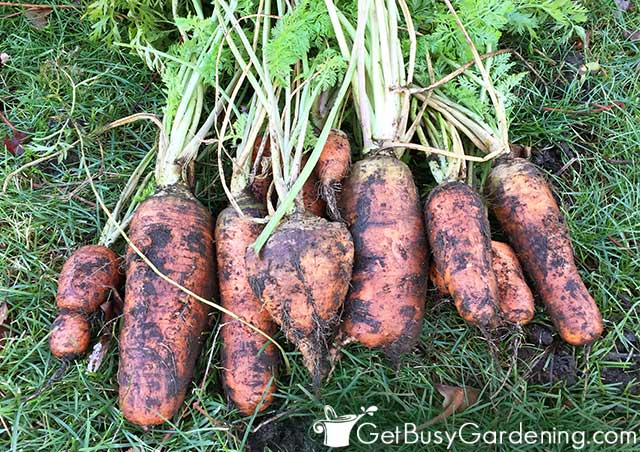
Planting Carrot Seeds
No matter what variety you choose, the planting process is always the same. In this section, I’ll tell you exactly when and how to plant carrot seeds.
When To Plant Carrot Seeds
For those of us who live in a cold area, the best time to plant carrot seeds is as soon as the ground is workable in very early spring.
If you live in a warm climate, sow them in the fall once the weather cools down, or in early winter.
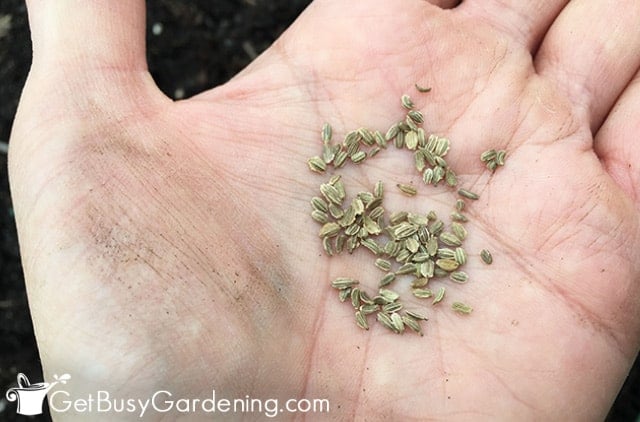
How To Plant Carrot Seeds Step-By-Step
Carrot seeds are easy to plant, so there’s no need to get anxious. But if you want everything to go smoothly, it is best to have all of your supplies ready first.
Supplies Needed
- Seeds
- Hand trowel
- Water
- Organic soil amendments (worm castings, compost, or granular fertilizer – optional)
Instructions
Step 1: Prepare the soil – Before planting carrot seeds, make sure you loosen up the soil, and remove any impediments, like sticks or rocks. Otherwise, they can inhibit healthy root development.
I also recommend amending your soil with compost or worm castings, and then mixing in an organic fertilizer.
Step 2: Determine the spacing – Since they don’t require a ton of space, you can plant your carrot seeds 1″ apart. Or, if you prefer, you can just scatter them in rows, and thin them out later.
Step 3: Plant the seeds – Make shallow trenches or holes in the soil, then drop the seeds in. Or, sprinkle them over the top, then gently work them down to about 1/4″ deep.
I like to use my finger to draw a shallow line in the dirt, then thinly sprinkle them into the trench I created.
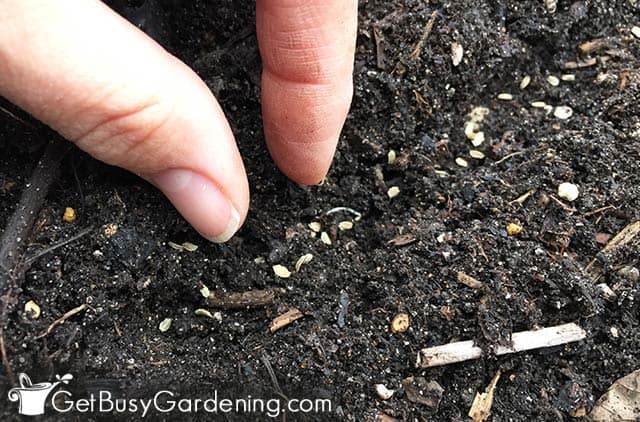
Step 4: Cover the seeds – Once you’re done planting, push the dirt back over them, and gently pack it down. That way, you’ll ensure the soil will come into contact with the seeds.
Step 5: Water – Moisten the soil in the bed using the lowest setting on your garden hose.
Using a gentle stream will ensure that you don’t displace the tiny seeds. The soil should be evenly moist, but never soggy.
Related Post: Canning Carrots – The Complete How To Guide
Carrot Seed Germination Time
The amount of time it takes carrot seeds to germinate can also vary. They are a bit slow, and it can take anywhere from 14-20 days to sprout.
So be patient, and don’t get discouraged if it seems to be taking forever. During this time, make sure the soil never dries out, or it can inhibit germination.

What Do Carrot Seedlings Look Like?
When they first pop out of the ground, carrot seedlings have two long and narrow leaves. Those are called the “seed leaves”.
All of the rest that form after that are called “true leaves”, and they look just like tiny baby carrot leaves.

How To Care For Carrot Seedlings
The work doesn’t end when your carrot seeds sprout. You will get the best results if you also ensure the seedlings are well cared for.
Water
For the best success, always keep the soil evenly moist, but never soggy. Dry or wet soil can kill the delicate seedlings. Use a moisture gauge to get it just right.
Fertilizer
Once your carrot seedlings have their first few true leaves, start feeding them with a liquid fertilizer at half strength. They love compost tea or fish emulsion too.
Thinning
If you didn’t have the patience to space them out properly when you planted your carrot seeds, you’ll need to thin the seedlings. Just make sure you never pull them out, or it could cause major damage to the ones nearby.
Related Post: Freezing Carrots With Or Without Blanching

FAQs
Below I’ve answered some of the most common questions about growing carrots from seed. If you still have a question after reading though this section, ask it in the comments below.
How many carrot seeds do you plant per hole?
When sowing fresh carrot seeds, you can plant one per hole. But if you’re using old seeds, place 2-3 per hole, and thin them later.
How deep do you plant carrot seeds?
Carrot seeds should always be planted twice as deep as they are wide – so only about 1/4″.
How can you germinate carrot seeds faster?
To help carrot seeds germinate faster, plant them in the cooler weather of spring or fall, and always keep the soil evenly moist. You could also try soaking the seeds before planting to help speed things up.
Do carrot seeds need light to germinate?
No, carrot seeds do not need light to germinate.
Do you soak carrot seeds before planting?
While it’s not necessary to soak carrot seeds before planting, doing so can help to speed up and increase germination rates.
Growing carrots from seed is amazingly easy and fun. With no need for transplanting or starting the seeds indoors, it really takes the burden out of planting them.
If you’re tired of struggling, and want to learn how to grow any plant you want from seed, then enroll in my online Seed Starting Course. It’s a wonderful, fun, self-paced course that will teach you everything you need to know to easily grow your own seedlings. Enroll and get started today!
Or, if you just need a refresher, then my Starting Seeds Indoors eBook is for you! It’s a quick-start guide that will get you planting seeds in no time.
More Posts About Growing Seeds
- How To Plant & Grow Lettuce From Seed
- How To Plant & Grow Radishes From Seed
- How To Grow Spinach From Seed
- How To Grow Cucamelons From Seed
- How To Grow Onions From Seed
Share your tips for planting and growing carrot seeds in the comments below.
Print The Step-By-Step Instructions
How To Plant Carrot Seeds
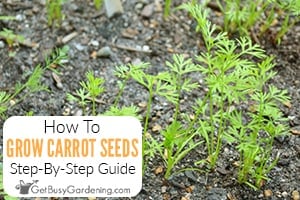
Carrot seeds can be finicky, but they aren't difficult to grow once you know how. First, gather all of your supplies. Then, simply follow these easy, step by step planting instructions.
Materials
- Seeds
- Water
- Organic soil amendments (worm castings, compost, or granular fertilizer - optional)
Tools
- Hand trowel
Instructions
- Prepare the soil - Loosen up the soil, and remove any impediments, like sticks or rocks. Then amend the soil with compost or worm castings, and mix in an organic granular fertilizer before planting.
- Determine the spacing - Plant your carrot seeds 1" apart. Or, if you prefer, you can just scatter them in rows, and thin them out once they start to grow.
- Plant the seeds - Make shallow trenches or holes in the soil, and drop the seeds in. Or, sprinkle them over the soil, then gently work them down to about 1/4" deep.
- Cover the seeds - Once you're done planting, push the dirt back over them, and gently pack it down to ensure the soil comes in contact with the seeds.
- Water - Moisten the soil using the lowest setting on your garden hose so you don't displace the tiny seeds. The soil should be evenly moist, but never soggy.
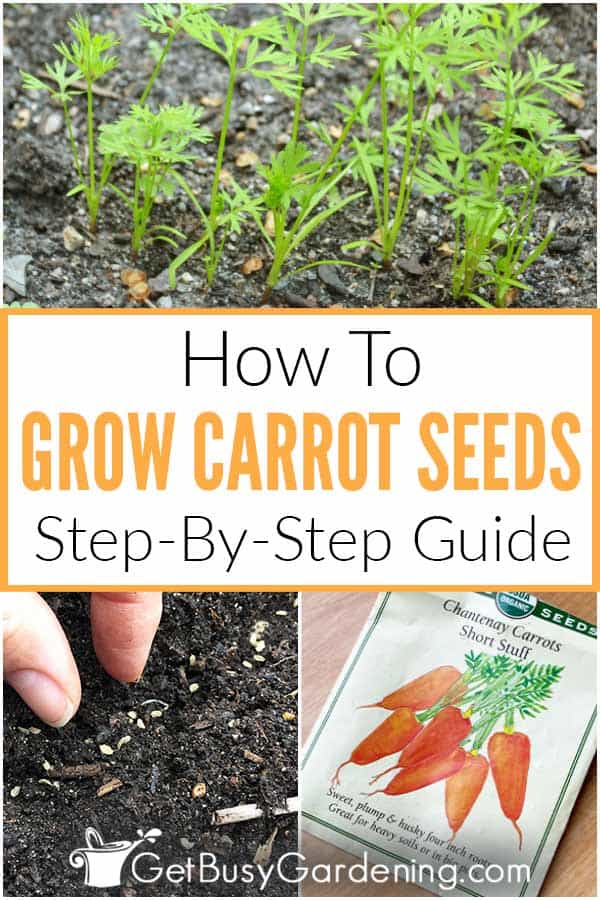
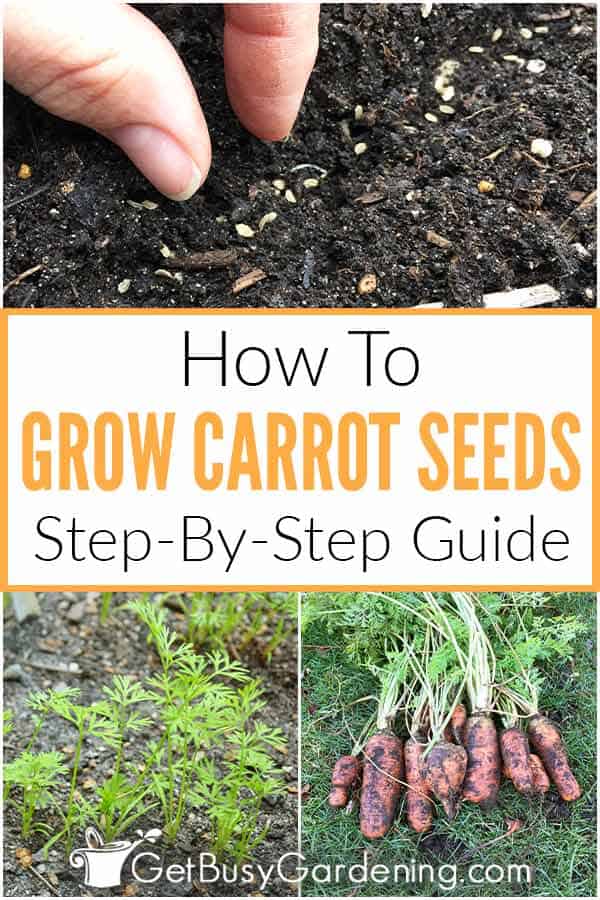


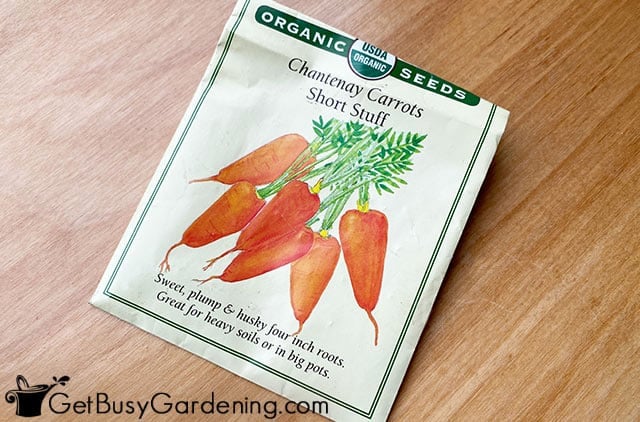


Novice carrot grower says
My carrot seed sprouted but only the cotyledons came up, no tire leave even after 2weeks. Why is this?
Amy Andrychowicz says
It can take 2 weeks for the true leaves to start growing on carrot seedlings, so that’s not unusual. As long as they look green and healthy, it might just be a matter of time.
Denise says
My weeds took over. I can see the carrot tops coming through but I can’t figure out how to reduce the weeds without damaging the tender carrot plants
Amy Andrychowicz says
If the weeds are mature and intentangled with your carrot seedlings, then it will be difficult for them to ever develop a sizable root. I would try keeping the weeds that are right next to the seedlings cut back to the ground, and then pulling out the rest that are far enough away. Hopefully cutting them back will knock them down enough so your carrots seedlings can take over.
Wendel says
SO how do you get the carrots to look like the traditional supermarket long-stemmed ones? Even your pictures above have then squat and fat. That is how mine came out and I have a 24″ deep raised bed.
Thank you for the information.
Amy Andrychowicz says
Sometimes it comes down to the type of carrot seeds you planted. There are many different varieties, some are short and fat, while others are long and skinny – and everything in between. That would be the first thing I’d check. Also, make sure you water deeply weekly, rather than giving them a small amount on the surface more often. The deeper you water, the longer the roots will be.
Eric says
You say not to pull the seedlings so as not to disturb the other seedlings. Do you just pinch them off then?
Thanks, Eric
Amy Andrychowicz says
To thin your carrot seedings, it’s safest to cut them off at the base using a sharp pair of precision pruners rather than pinching them. Here’s a detailed article that may help you out… How & When To Thin Seedlings.
John Page says
A way to spread carrot seeds is to mix the seed with a handful of washed sand thoroughly and then spread evenly in your shallow trench then cover with a potting mix. then water regularly to keep moist .
Works well with radishes as well. You won’t need nearly as much thinning out
Amy Andrychowicz says
Great tip for an easier way to evenly sow those tiny carrot seeds. Thanks for sharing! 🙂
aiger says
this is really helpful because I have some carrot seeds in my bag
thanks:)
Amy Andrychowicz says
You’re welcome! Hope your carrot seeds grow well for you. 🙂
Jeannette Rexach says
Hi, I live in San Juan, Puerto Rico. I planted purple carrot seeds in a pot last September after reading your post & in December I checked & they had not grown so I just forgot about them. To my surprise about two weeks ago picking some tomatoes I noticed the carrots had grown. Why they took so long frankly is a big ?
Amy Andrychowicz says
Oh, that’s great news! Glad to hear your carrot seeds grew. I’m not sure why they took so long to germinate either, they have a very wide temperature range for germination, so I don’t think that was the problem. Maybe the the soil was too dry? They need consistently moist soil to germinate.
Perla Sofia Curbelo says
Thanks for the tips, Amy!
This season is my first time growing carrots. I bought the seedlings from a trusted nursery. I’m growing them in containers. As you recommend, they’re in loose soil and under full sun. Here in Puerto Rico the weather is getting much hotter (mid 80’s & 90’s), so i hope it doesn’t disturb them! They look very happy! Looking forward to harvest them in early Summer!
Amy Andrychowicz says
You’re welcome! Good luck, I hope they will grow well for you!